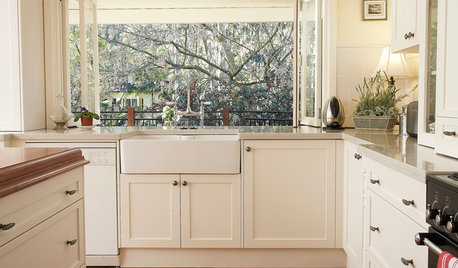Don't know jack about dishwashers and have to finalize list
BentleyM
11 years ago
Related Stories

HEALTHY HOMEWhat You Need to Know About Dust and How to Fight It
Breathe easier with these 10 tips for busting mites, dander and other microscopic undesirables
Full Story
KITCHEN SINKSEverything You Need to Know About Farmhouse Sinks
They’re charming, homey, durable, elegant, functional and nostalgic. Those are just a few of the reasons they’re so popular
Full Story
MATERIALSInsulation Basics: What to Know About Spray Foam
Learn what exactly spray foam is, the pros and cons of using it and why you shouldn’t mess around with installation
Full Story
LIGHTINGWhat to Know About Switching to LED Lightbulbs
If you’ve been thinking about changing over to LEDs but aren't sure how to do it and which to buy, this story is for you
Full Story
WORKING WITH PROSWhat Do Landscape Architects Do?
There are many misconceptions about what landscape architects do. Learn what they bring to a project
Full Story
FURNITUREHow to Buy a Quality Sofa That Will Last
Learn about foam versus feathers, seat depth, springs, fabric and more for a couch that will work for years to come
Full Story
MOST POPULARWhat to Know About Adding a Deck
Want to increase your living space outside? Learn the requirements, costs and other considerations for building a deck
Full Story
REMODELING GUIDESWhat to Know About Budgeting for Your Home Remodel
Plan early and be realistic to pull off a home construction project smoothly
Full Story
WORKING WITH PROSWhat to Know About Concept Design to Get the Landscape You Want
Learn how landscape architects approach the first phase of design — and how to offer feedback for a better result
Full Story
GARDENING FOR BIRDSWhat to Know About Birds Nesting in Your Yard
Learn how to observe, record data and help ornithologists with NestWatch’s citizen science project understand bird trends
Full Story





fauguy
maries1120
Related Professionals
El Dorado Hills Kitchen & Bathroom Designers · Henderson Kitchen & Bathroom Designers · Riviera Beach Kitchen & Bathroom Designers · Southbridge Kitchen & Bathroom Designers · South Farmingdale Kitchen & Bathroom Designers · Wood River Kitchen & Bathroom Remodelers · Allouez Kitchen & Bathroom Remodelers · Bloomingdale Kitchen & Bathroom Remodelers · Los Alamitos Kitchen & Bathroom Remodelers · Eufaula Kitchen & Bathroom Remodelers · Cranford Cabinets & Cabinetry · Crestview Cabinets & Cabinetry · Gaffney Cabinets & Cabinetry · Jefferson Valley-Yorktown Cabinets & Cabinetry · Tabernacle Cabinets & Cabinetryasolo
BentleyMOriginal Author
asolo
dan1888
mojavean
asolo
maries1120
mojavean
BentleyMOriginal Author
fauguy
BentleyMOriginal Author
joe_in_philly
mojavean
asolo